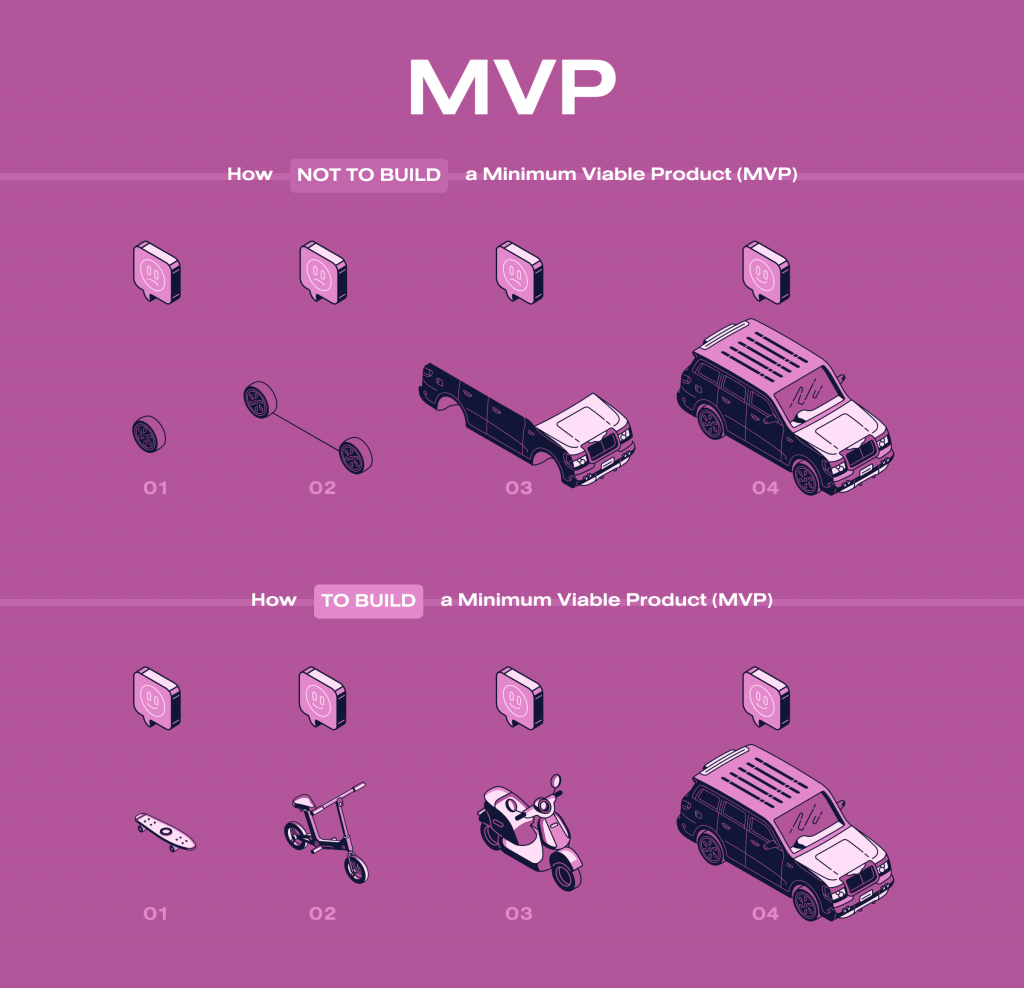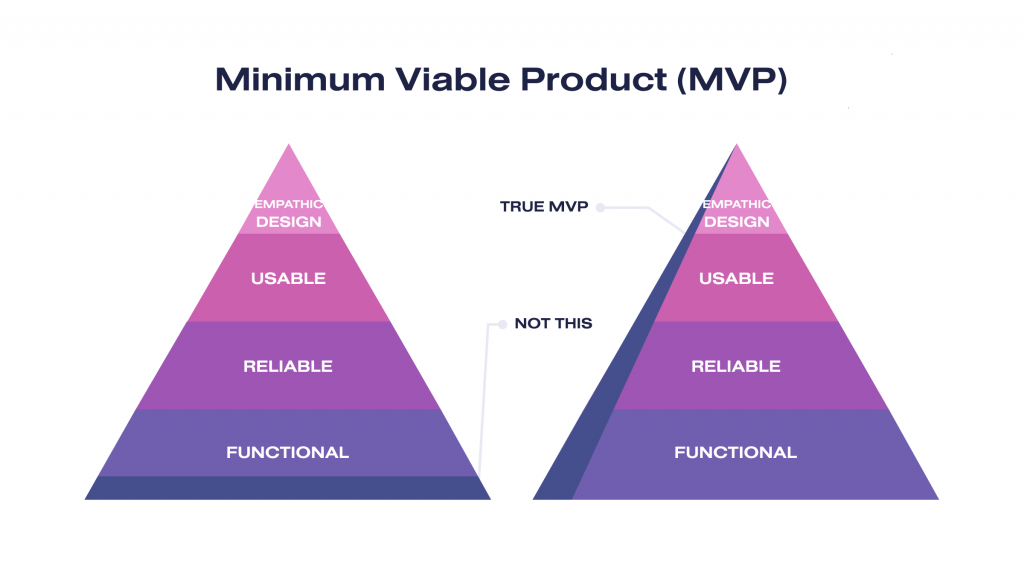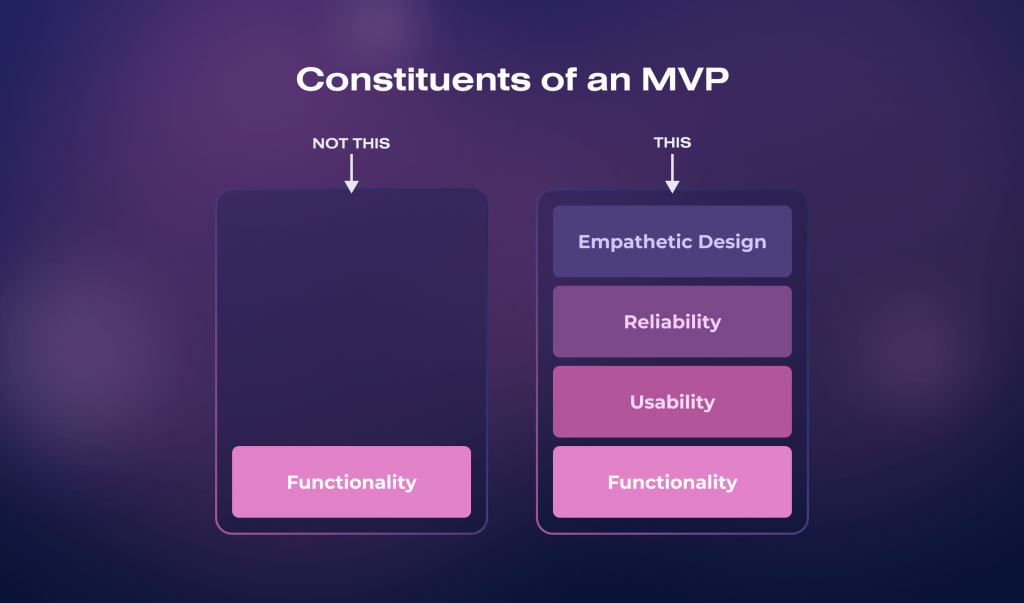Amazon is one of the most successful examples of MVP. The e-commerce giant started as an online bookstore with all the characteristics of an MVP. Soon after, Jeff Bezos and his team set about the task of thinking about which products could be sold online. Among multiple options, they came up with only five products: videos, books, software, computers, and even CDs.
Interested in learning more about what an MVP is? We invite you to learn how to build a minimum viable product in 2024. Enrich your knowledge to increase the chances of success of your career or business and minimize the risks.
Key points
What is an MVP?

Launching a new product to the market is a challenge for any entrepreneur since he or she could invest a large part of his or her savings and a lot of time in developing a product that finally fails when it is launched to the market.
To avoid this problem, startups and many other ventures launch a minimally viable product under a calculated risk. This is nothing more than a first functional version of your idea, but it is key to understand first-hand its viability.
MVP is a prototype made with minimal effort to collect as much data as possible from the customers themselves. Thanks to it, it is possible to validate the hypothesis for which it has been designed. That is, it helps to know if it responds to the needs of potential customers.
Benefits of creating an MVP for startups

Developing a minimum viable product offers several advantages to startups:
- It decreases risks. Designing a minimum viable product allows startups to have enough room for maneuver to perfect their service and adapt it to customer demands. In this way, entrepreneurs ensure that the product will satisfy the market need, apply those features that users demand, and reduce the degree of uncertainty about its reception by consumers.
- It reduces costs. Developing a minimum viable product saves time and money, as less time is spent on developing key aspects or functionalities of the service since only the essential functionalities are integrated, which helps devote more effort to future development phases. This allows the product to be presented to the market quickly so customers can test it.
- It helps to improve the product with the feedback received. Developing an MVP helps startups get feedback on whether their product fits the market and also on how they can improve it before its final launch. There is a practical example. Entrepreneurs Brian Chesky and Joe Gebbia decided to rent out their apartment. They posted the ad on a website and soon had three customers. The information revealed by these users allowed these entrepreneurs to focus on product development and create Air Bed and Breakfast, now known as Airbnb.
- It indicates whether pivoting is necessary. Of the 30,000 products launched each year, 95% fail, according to a Harvard Business Review professor, Clayton Christensen. According to CB Insights, the figure is supported by the fact that the products developed do not meet any market demands.
This shows that launching a minimum viable product is key to success. Suppose the reception from users is not positive. In that case, testing the prototype gives entrepreneurs the perspective to decide whether to change the company’s business model or fine-tune the product to impact the market.
MVP development challenges
While MVP development has several advantages, it faces a few challenges. These are the difficulties that teams encounter when creating the minimum variable product:
- Identifying key features
- Aligning team expectations
- Communicating with users
- Maintaining simplicity of design
- Adjusting to market changes
An experienced team like SoloWay Tech can help you to deal with these challenges effortlessly and professionally.
How do you create a minimum viable product (MVP)?

It is necessary to follow 3 steps to develop a minimum viable product (MVP):
- Define the problem. The first step is defining the problem or challenge the product developed will solve. This problem or challenge will allow you to identify the target audience and its motivations for choosing the product. In this phase, performing a SWOT analysis (an acronym for strengths, weaknesses, opportunities, and threats) to refine the value proposition is also relevant.
- Designing the customer experience. After answering the need or demand covered by the product, it is important to delimit the path users take through the product and divide it into milestones. For example, in the case of Spotify, users must first find the group or artist they are looking for. They then select the music and play it. Identifying the most obvious steps helps improve the customer journey.
- Gather the essential features. Once the entrepreneur has defined the value proposition, the problem it solves, and the business model, he or she must narrow down among those features that are essential for the launch. Once this is done, it is necessary to prioritize the essential ones. They are the ones that will be the most interesting to customers and the ones that will solve the problem identified first. In this process, it is important to have a reliable team like SoloWay Tech to keep the focus on the main features since customer feedback can divert attention to other features that are not so important.
Finally, to code a minimum viable product, it is advisable to keep in mind that it must meet 4 criteria:
- Functionality. It integrates the basic functions to solve a need.
- Reliability. The developed solution must be secure.
- Usability. It is useful for those who try it.
- Empathetic Design. It must attract the attention of users.
Creating a minimum viable product is essential for startups wanting to ensure their entrepreneurial ecosystem growth.
MVP development with SoloWay Tech: our cooperation process overview

The diverse SoloWay Tech team includes over 50 in-house experts: developers, UI/UX designers, QA engineers, copywriters, on-site illustrators, and project managers. So, every corner of your MVP project will be covered. We work the following way:
- Problem analysis. We deeply analyze your situation to understand your business, requests, and market position.
- Solution creation. We form a team to design optimal project solutions, starting with prototyping and UI/UX design.
- MVP development. Upon approval, we use Agile methodology to launch your project as an MVP.
- Product integration. We release the product, aiding integration into your tech infrastructure, with 100% intellectual property ownership.
- Support and updates. Post-release, we provide ongoing support to ensure your product runs optimally.
If you are looking for a reliable MVP development partner, investigate our case studies.
Five famous MVP examples
Some of the most successful tech companies out there had an MVP. Yes, Uber didn’t expand that way out of anywhere. Facebook didn’t fortuitously become the largest social network on the planet. Let’s take a look at these examples.
We said that an MVP is the minimum investment to know if someone will pay for what you’re selling. You can think of it as the minimum “thing” you need. Whatever the minimum amount it takes to see if someone will pay money for it, it’s your MVP.
It’s hard to imagine that Facebook was once a website solely connecting students at Harvard University. Facebook’s MVP was called Thefacebook. It was a simple platform that connected students in the same classes by allowing them to post messages in shared forums.
By introducing Facebook to a very narrow segment of the market, Mark Zuckerberg validated his idea and gained a critical mass that triggered the adoption of the social network. We all know how the story ends.
Uber
When Uber launched, it was called UberCab. It only worked on iPhone or by SMS and was only available in San Francisco. It was 2009. Uber’s MVP was enough to prove that the idea of a cheap ridesharing service had a market. The learning and validated data from the first app helped Uber scale the business quickly to where it is today. In January 2024, Uber was worth nearly $130 billion and is active in nearly 90 countries worldwide.
Airbnb
Airbnb wasn’t always a $85 billion company or called that. It was Airbed & Breakfast. In late 2007, its founders, Brian Chesky and Joe Gebbia, who had recently moved to San Francisco, had a problem to solve. They needed help paying rent. They created an MVP to test whether strangers would be willing to pay to stay in their homes. Their MVP had no robust website or options to select various dates, locations, or prices. They focused on people traveling to San Francisco for tech conferences.
Dropbox
Instead of building a complete solution that would require overcoming extreme technical hurdles and months of development, Drew Houston, one of Dropbox’s co-founders, created a simple three-minute video demonstration of their technology. It was aimed at high-tech users. The video explained how easy it is to use the file-sharing platform. The video led to 75,000 people waiting for a beta invitation.
In Dropbox’s case, Houston used a video as a minimum viable product to validate his hypothesis that people wanted file-sharing software that “just works like magic.” The flocks of people who signed up successfully validated his hypothesis.
Rappi
Rappi is one of fewer than 20 Latin American startups that have achieved Unicorn status, meaning they have a valuation above $1 billion. Simón Borrero, its CEO and co-founder, had a web design company. There, they developed Grability, a shopping app that simulated the movement of a product to the shopper’s basket. And well, now they are a company that operates in several countries.
Conclusion: how do you measure success after building an MVP?
A successful minimum viable product will tell you what features are the best, what needs to be changed, or if your product has market potential. If your MVP is not successful, that does not mean failure. You have tremendous flexibility at the beginning of your product development, so you can continue to adjust until you get the ideal response. Think of an MVP as bait: you won’t be able to attract any customers without something essential at the end of your hook.
You’ll get feedback and observation over time, even with multiple MVPs. Remember, a successful MVP is no guarantee of long-term success. You are minimizing risk and building confidence in your process to create something that customers will value. You can restart the process with new data and new assumptions several times.
Finally, let’s say goodbye with some practical tips that can help you to succeed with your minimum viable product:
- Focus on your product’s minimum essential feature. This will determine the scope of your MVP strategy.
- Develop your MVP as quickly as possible. To do this, you can turn to us at SoloWay Tech, as we have tremendous expertise in MVP development.
- Find a balance between feasibility and aesthetics. If you aim for a functional product, try to make it useful and easy to use without neglecting its appearance.
Remember that it is unnecessary to search for perfection constantly. Improvements to your product or service will come in time. It’s just a matter of keeping trying based on user feedback and statistics.
If you want to start working on your MVP today and get it in 3 months, contact us right now. We will get back to you shortly.




